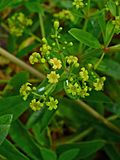Note: This is a project under development. The articles on this wiki are just being initiated and broadly incomplete. You can Help creating new pages.
Difference between revisions of "Rubia tinctorum"
| Line 1: | Line 1: | ||
[[File:Rubia_tinctorum_001.JPG|thumb|right]] | [[File:Rubia_tinctorum_001.JPG|thumb|right]] | ||
| + | '''Rubia tinctorum''' is a Evergreen Perennial up to 1.00 metres tall. It is harvested from the wild for local use as a medicine and source of materials.. | ||
==Uses== | ==Uses== | ||
| − | {{Uses|}}, {{Uses|}}, {{Uses|}}, {{Uses|}}, {{Uses| | + | {{Uses|Bladder stones}}, {{Uses|Kidney stones}}, {{Uses|Amenorrhoea}}, {{Uses|Dropsy}}, {{Uses|Jaundice}}.<ref name="Uses"/> |
==Parts Used== | ==Parts Used== | ||
| Line 7: | Line 8: | ||
==Chemical Composition== | ==Chemical Composition== | ||
| − | <ref name="chemical composition"/> | + | It contains Compounds found in Rubia tinctorum include purpurin (oxyalizarin; 1,2,4-trihydroxyanthraquinone), mollugin (6-hydroxy-2,2-dimethyl-2H-naphtho[1,2-b]pyran-5-carboxylic acid, methyl ester), 1-hydroxy-2-methylanthraquinone, 2-ethoxymethylanthraquinone, rubiadin (1,3-dihydroxy-2-methylanthraquinone).<ref name="chemical composition"/> |
==Common names== | ==Common names== | ||
| Line 28: | Line 29: | ||
==Habit== | ==Habit== | ||
| − | {{Habit|}} | + | {{Habit|Evergreen perennial}} |
==Identification== | ==Identification== | ||
| Line 47: | Line 48: | ||
==Mode of Propagation== | ==Mode of Propagation== | ||
| − | {{Propagation|}} | + | {{Propagation|Seeds}}, {{Propagation|Division in spring}}. |
==How to plant/cultivate== | ==How to plant/cultivate== | ||
| − | <ref name="How to plant/cultivate"/> | + | Prefers a light sandy soil in full sun. Plants grown in fertile well-limed soils produce more pigment in the root.<ref name="How to plant/cultivate"/> |
==Commonly seen growing in areas== | ==Commonly seen growing in areas== | ||
| − | {{Commonly seen|}}, {{Commonly seen| | + | {{Commonly seen|Neglected ground}}, {{Commonly seen|Hedgerows}}. |
==Photo Gallery== | ==Photo Gallery== | ||
| Line 65: | Line 66: | ||
<references> | <references> | ||
| − | <ref name="chemical composition">[ | + | <ref name="chemical composition">[https://www.ncbi.nlm.nih.gov/books/NBK326613/ Chemical constituents]</ref> |
<ref name="Leaf">[Morphology]</ref> | <ref name="Leaf">[Morphology]</ref> | ||
| − | <ref name="How to plant/cultivate">[Cultivation]</ref> | + | <ref name="How to plant/cultivate">[http://temperate.theferns.info/plant/Rubia+tinctorum Cultivation]</ref> |
<ref name="Uses">Indian Medicinal Plants by C.P.Khare</ref> | <ref name="Uses">Indian Medicinal Plants by C.P.Khare</ref> | ||
</references> | </references> | ||
==External Links== | ==External Links== | ||
| − | * [ ] | + | * [https://pfaf.org/user/Plant.aspx?LatinName=Rubia+tinctorum Rubia tinctorum on pfaf.org] |
| − | * [ ] | + | * [https://www.sciencedirect.com/topics/agricultural-and-biological-sciences/rubia-tinctorum Rubia tinctorum on sciencedirect.com] |
| − | + | ||
[[Category:Herbs]] | [[Category:Herbs]] | ||
Latest revision as of 18:21, 30 July 2020
Rubia tinctorum is a Evergreen Perennial up to 1.00 metres tall. It is harvested from the wild for local use as a medicine and source of materials..
Contents
[hide]- 1 Uses
- 2 Parts Used
- 3 Chemical Composition
- 4 Common names
- 5 Properties
- 6 Habit
- 7 Identification
- 8 List of Ayurvedic medicine in which the herb is used
- 9 Where to get the saplings
- 10 Mode of Propagation
- 11 How to plant/cultivate
- 12 Commonly seen growing in areas
- 13 Photo Gallery
- 14 References
- 15 External Links
Uses
Bladder stones, Kidney stones, Amenorrhoea, Dropsy, Jaundice.[1]
Parts Used
[[:Category:Herbs with used in medicine|]], stem, leaves, Root.
Chemical Composition
It contains Compounds found in Rubia tinctorum include purpurin (oxyalizarin; 1,2,4-trihydroxyanthraquinone), mollugin (6-hydroxy-2,2-dimethyl-2H-naphtho[1,2-b]pyran-5-carboxylic acid, methyl ester), 1-hydroxy-2-methylanthraquinone, 2-ethoxymethylanthraquinone, rubiadin (1,3-dihydroxy-2-methylanthraquinone).[2]
Common names
| Language | Common name |
|---|---|
| Kannada | |
| Hindi | |
| Malayalam | |
| Tamil | |
| Telugu | |
| Marathi | |
| Gujarathi | |
| Punjabi | |
| Kashmiri | |
| Sanskrit | |
| English |
Properties
Reference: Dravya - Substance, Rasa - Taste, Guna - Qualities, Veerya - Potency, Vipaka - Post-digesion effect, Karma - Pharmacological activity, Prabhava - Therepeutics.
Dravya
Rasa
Guna
Veerya
Vipaka
Karma
Prabhava
Habit
Identification
Leaf
| Kind | Shape | Feature |
|---|---|---|
Flower
| Type | Size | Color and composition | Stamen | More information |
|---|---|---|---|---|
| {{{5}}} |
Fruit
| Type | Size | Mass | Appearance | Seeds | More information |
|---|---|---|---|---|---|
Other features
List of Ayurvedic medicine in which the herb is used
Where to get the saplings
Mode of Propagation
How to plant/cultivate
Prefers a light sandy soil in full sun. Plants grown in fertile well-limed soils produce more pigment in the root.[4]
Commonly seen growing in areas
Photo Gallery
References
- Jump up ↑ Indian Medicinal Plants by C.P.Khare
- Jump up ↑ Chemical constituents
- Jump up ↑ [Morphology]
- Jump up ↑ Cultivation
External Links
- Ayurvedic Herbs known to be helpful to treat Bladder stones
- Ayurvedic Herbs known to be helpful to treat Kidney stones
- Ayurvedic Herbs known to be helpful to treat Amenorrhoea
- Ayurvedic Herbs known to be helpful to treat Dropsy
- Ayurvedic Herbs known to be helpful to treat Jaundice
- Herbs with used in medicine
- Herbs with stem used in medicine
- Herbs with leaves used in medicine
- Herbs with Root used in medicine
- Habit - Evergreen perennial
- Index of Plants which can be propagated by Seeds
- Index of Plants which can be propagated by Division in spring
- Herbs that are commonly seen in the region of Neglected ground
- Herbs that are commonly seen in the region of Hedgerows
- Herbs



